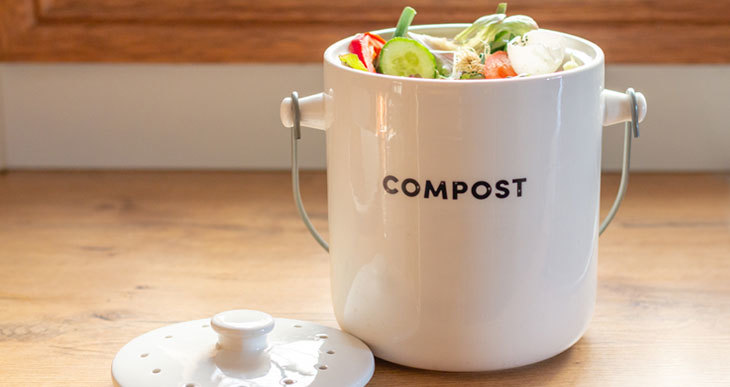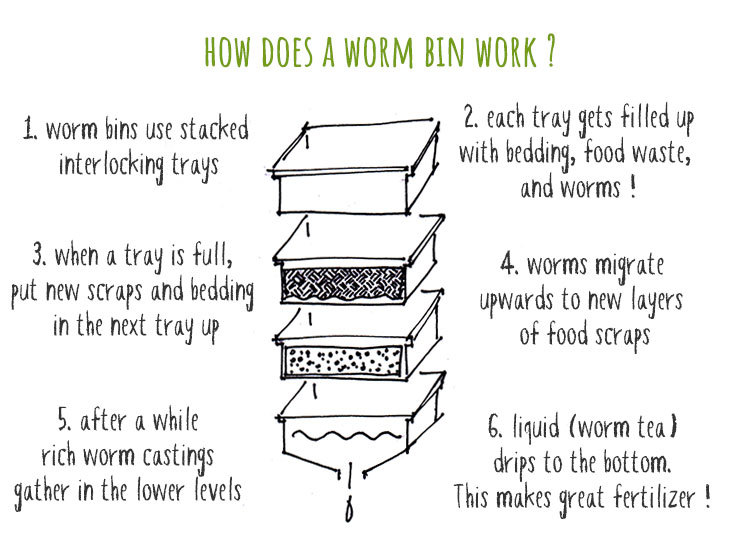If you’re like me and you enjoy cooking, then you produce an abundance of food scraps every time you’re in the kitchen! Just about all types of organic refuse makes excellent compost material. And composting household scraps is a great way to make something beneficial for your plants, while reducing your home’s weekly waste production and carbon footprint !
But how can you make compost from kitchen waste? Composting kitchen scraps is relatively straightforward and doesn’t require much specialized knowledge. You just need to know that things like animal products and oils shouldn’t be composted. But beware… Kitchen scraps alone will not result in compost!
You are watching: How To Make Compost From Kitchen Waste (The Easy Way)
It’s a common mistake to think that leftovers from your kitchen are enough to produce rich compost. Organic household refuse is high in nitrogen and is known as “green” composting material. For successful composting you need to mix this with plenty of “brown” materials which have a high carbon content.

There are several different options available for composting food waste at home.
In this article, you’ll learn the benefits of composting kitchen waste, what types of materials can and can’t be composted, as well as how to easily start composting your own food scraps.
Composting Kitchen Waste
I like to think of composting as nature’s way of recycling. Bacteria and fungi can be used as a way to break down organic waste and turn it back into soil. A couple of inches of compost is enough to feed and protect your plants for a whole season !
And food scraps are something we produce all year long. So why throw this valuable resource in your garbage bin?
More than half of the daily waste that a household generates is organic matter. So composting can make a huge difference!
Composting your kitchen waste is easy, and you have a number of options available. All of your fruit and vegetable scraps, eggshells, and other organic materials can all be composted. You can even recycle old newspapers and other paper materials.
What Kinds of Kitchen Refuse Can Be Composted?
Ok… Let’s be honest.
The first thing you need to know is “what’s the right kind of kitchen waste to add to your compost”?
Because the wrong kind isn’t going to help your composting efforts. But what should be included, and what can’t ?
To be composted, the material you choose needs to be biodegradable. But even then, certain types of leftovers should be avoided.
Here are some things to keep out of your composter:
- Meat, bones, or other animal products (gristle, fat, skin.)
- Fish products
- Dairy (milk, cheese, yogurt, etc.)
- Animal waste
- Any kinds of grease or oils
These products either break down too slowly, cause really smelly compost, or can attract rodents and other pests. When added to your compost they can slow down the decomposition process of all the other “good” ingredients and cause an imbalance in your compost.
Aside from those items, most kitchen waste can be composted. You can pretty much add whatever other organic matter to your composter without any issues.
Read more : Do matching appliances matter? We asked the experts to find out
With a little organization you can easily sort the good from the bad. I keep a small compost caddy on the countertop. This makes it super easy to stockpile food scraps until I take them out to the compost pile. Look for one which is designed to avoid odors and can be cleaned quickly (this one on Amazon is dishwasher proof).

You can compost fruits and vegetables even if they’ve gone bad or are starting to get moldy. You can also compost almost anything made of flour like noodles, crackers, or stale bread (although sweet baked goods can attract ants). The same goes for cooked grains like rice or barley. Even eggshells can be included if you grind them up first, since they provide a source of calcium.
As for cooked food waste, remember the same rules as above. If it’s vegetable based then it should be okay. But if it contains any animal products or a lot of oil, you should avoid adding it to compost.
How To Compost Kitchen Waste?
For the most part, composting is pretty low-effort and just requires tossing waste into your chosen type of composter. But there’s one important thing to keep in mind.
Food scraps alone will not produce compost.
Be sure to include a good balance of both kitchen waste (greens) as well as carbon-rich materials (browns) when you add things to your composter.
Brown items include straw or hay, small wood chips, or sawdust. A readily available source of brown matter is dead leaves. It’s best to store dry leaves in the fall for use during the rest of the year (you really can’t get enough of these wonderful things !). But if you don’t have any organic brown matter available you can also use shredded paper or cardboard.
To help your waste turn into compost as quickly as possible, it helps to cut your kitchen materials into small pieces no more than an inch long. Smaller scraps have more surface area, which allows bacteria to break them down more quickly.
Easy ways to compost kitchen waste
When it comes to choosing how you will compost, it will largely depend on your personal situation. The method you choose depends on the space you have available, and the time you want to devote to composting.
how to compost kitchen waste in apartments
If you live in an urban environment like an apartment and don’t have any outdoor space, your best bet is probably a worm bin (Amazon link) also referred to as vermicomposting.
The problem if you don’t have a yard is you may have trouble collecting enough organic stuff to make a decent compost heap! This makes a worm bin the ideal solution.
Heck… Even if you don’t live in an apartment, a worm bin might be the best thing you can own for processing your kitchen waste !
The wonderful thing about worms is that whatever comes out the back, is more nutrient rich than what goes in their front ! You end up with nutrient rich worm castings.
Don’t worry – these systems are completely odorless. And the process can be done all year round, even in the winter. All you do is feed the worms your leftovers, preferably chopped up, or even mixed in a blender.

Try to locate your wormery somewhere with a temperature of between 50°F to 84°F (10°C to 29°C). You also need to add special worms, often called “red wigglers” which can be purchased by mail order.
Using a worm composting bin like this worm factory on Amazon, you end up with worm castings which look similar to coffee grounds. This substance is five times richer than fertile soil and contains useful microorganisms. You can use this precious compost for your potted plants and flowers or as a seed-starting medium.
Read more : DIY: Painting our Kitchen Cabinets with White Milk Paint
related: composting in an apartment
Composting kitchen waste outside
An incredibly quick and easy method for composting food waste outdoors is to simply bury it in the ground!

Pit Composting
This kind of composting is known as trench composting or pit composting. One of the advantages of this method is that the composting materials stay cool and damp in the summer, and warmer in the winter, thus helping the decomposition process.
Simply dig a hole 12 to 14 inches deep and bury your leftovers. Try to do this in layers of “green” then “brown” materials. Once buried, anaerobic bacteria start the decomposition, and worms will also help to digest the food waste. When everything has decomposed, you can either dig it up and use it in your yard, or plant something directly on top of the pit !
Some people do this in long trenches for gardening crops. However, if you do this, make sure you leave it to decompose for a good long period of time to allow the process to destroy harmful bacteria. One or even two seasons is recommended.
Compost Tumbler
For those with a little bit of outdoor space like a patio, but maybe don’t want to devote too much time to composting, a tumbler composting bin such as this one on Amazon is probably your best solution.
Compost needs turning regularly to make sure the decomposing materials have enough oxygen to do their work. One big upside to these models is that they’re very easy to aerate. Simply give them a spin every few days. No digging or turning with a spade required.
People with larger yards can consider a more standard compost bin like this model(Amazon link). When selecting a bin design, I recommend looking for one with a wide opening on top so it’s easy to aerate. You also want a lid that securely fastens as well. Having an opening at the bottom where you can shovel out finished compost is a plus as well.
DIY kitchen waste compost bin
If you have an extra bucket laying around and don’t want to pay for a composting bin, you can make a DIY composting setup of your own. They won’t be able to hold large amounts of compost, but it’s one way to get started.
Begin by drilling some holes on the sides and bottom of the bucket. You will want something to keep the bucket raised off the ground, so air can get in underneath and prevent the contents from becoming anaerobic. Place a tray underneath the bucket to catch water that comes out during the composting process. This liquid is sometimes called compost tea, and can be added directly to your garden as a fertilizer.
Try to alternate the contents of your bucket into alternating layers of green matter (kitchen waste) and brown matter (yard waste like dry leaves).
Mix the contents of the bucket one or two times per week to keep it aerated. This will help add extra oxygen and speed up the decomposition process. If the contents get too wet, try adding more dry leaves. If it gets too dry, you can mist it with a hose to add a little moisture.
Once one bucket is full, you can start another bucket. Each bucket will take about 40 to 60 days for the contents to fully decompose. Then it can be emptied into your garden and you can start the whole process over again !
Depending on how much kitchen waste your house goes through, you might need to have about three or four buckets so that you can constantly cycle between them.
Conclusion
Composting your kitchen waste is an easy way to cut down on the amount of garbage that your home produces, and is one way to start living more sustainably.
And the best part?
You end up with a fantastic soil amendment which provides everything your plants need to grow happy and healthy !
Source: https://gardencourte.com
Categories: Kitchens

